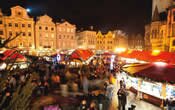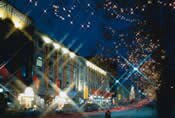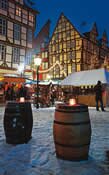Inflight Magazine of Brussels Airlines
Welcome to the Inflight Magazine of Brussels Airlines
Food & drink
Luciano Di Gregorio brims with the festive spirit after checking out the delicacies on offer at five of Europe’s most famous Christmas markets
Framed by ancient squares and narrow alleys, European Christmas markets are eclectic affairs of culture and creativity, with a focus on hearty food and family fun. Nothing unlocks the potential of the imagination like a market’s shimmering lights and vibrant colours. So it’s no surprise that from November to January, coats are dusted, scarves are donned and often-adverse weather conditions are braved for the chance to be immersed in the convivial spirit that seems to effortlessly unify an entire continent. Mulled wine warms chilled hands as smoke wafts from roasted meat stalls and each city celebrates the festive season in their own unique style.
Naples
Since William the Conqueror was busy shuffling the Anglo-Saxons out of Hastings, the Neapolitans have been carving and painting terracotta nativity statuettes. Lining the crumbling alleyways around Via San Gregorio Armeno, the artisan stalls of the city’s historic Christmas market are dotted with Virgin Marys holding tightly wrapped holy infants and wise men rubbing shoulders with Joseph the carpenter. But if these religious relics aren’t to your taste, perhaps a miniature scowling Silvio Berlusconi taking a beating from ‘holy citizens’ will suffice. Peruse such tongue-in-cheek wares while devouring a warm crêpe filled with Nutella.
The Via San Gregorio Armeno market operates from early December until Christmas Eve.
 Prague
Prague
Prague’s impossibly picturesque Old Town Square, the site of the city’s most popular Christmas market, sparkles under the watchful eye of thousand-year-old churches and mythical clock towers. The bite to the air doesn’t seem to concern the Czechs, who descend from far and wide with gusto. This city is a fairytale at any time of the year, but the festive atmosphere, with locals drawing strength from a cup of svarák (hot wine) under the steeples of the Týn Church, is truly special. Weaving amongst the clusters of huddled adults, goggle-eyed children devour the diverse range of Christmas ornaments for sale, tucking into párek v rohliku (a Czech sausage in a bun) with as much fervour as they would an ice cream in the height of summer.
The markets in Prague operate from the end of November until early January.
 Oslo
Oslo
In Oslo, the Christmas lights defy a darkness that has, during the previous months, begun to cloak the city. The Rådhusplassen market transforms Oslo’s City Hall and breathes life back into the surrounding alleyways. Lights are paramount here, and traditional ornaments are largely excluded from the market’s Christmas trees in favour of swathing them in copious illuminations. Enclosed from the cold by cosy, star-topped stalls selling julegrøt (‘yule porridge’ made with rice) and varm kakao (warm cocoa), locals vie for the best of the city’s famed ornamental hearts and stars to decorate their homes. Swishes of colourful fabric adorning marionettes elicit a variety of childlike ‘oohs’ and ‘ahhs’, drowned out by the musical stylings of performers on the nearby stage. Indeed, the prospect of a free, quality performance draws Oslo residents and their families in droves.
The Rådhusplassen market runs from the end of November until just before Christmas.
 Vienna
Vienna
A Viennese Christkindlmarkt is a regal affair to match the city’s stately façade, and sophisticated stalls framed by gothic architecture beckon visitors to join in the yuletide celebrations. The Town Hall’s expanse of parkland and trees is bedecked with glittering lights, while stalls sell tender cuts of beef washed down with hot, spicy wine and followed by a selection of the country’s quintessential – not to mention scrumptious – gingerbread men. If you’re wondering where all the children have gone, look no further than the crowd of youngsters at the Post Office in the Clouds, scribbling creatively to Christkind to request festive gifts.
And don’t miss the market’s various themed Christmas trees, such as the Kasperl (tree with seals) and the Herzerlbaum (tree of hearts).
Join the Town Hall’s Christkindlmarkt festivities between the end of November and Christmas day.
 Hannover
Hannover
In the streets and squares of Hannover’s majestic altstadt at this time of year, the jauntiness is almost tangible. The city’s otherwise drab Central Station receives a full makeover, becoming the site of the main Weihnachtsmarkt festivities. Numbering around 80, the stalls here are framed by flashing lights and singing Santas. Decorative ornaments are an obsession in the imperial streets of Hannover, and market-goers can purchase them in a variety of shapes and sizes. If you’re in need of respite during the shopping frenzy, a succulent selection of belly-bursting meat dishes should restore the festive spirit, while fingers can be thawed against mugs of the city’s celebrated glühwein, a warm and potent sweet wine that’s sure to dull some of your cognitive senses. For a more active experience, the nearby zoo offers toboggan runs and a decorated ice rink to get the blood pumping and keep the cold at bay.
The Central Station market is open from late November until a few days before Christmas. The celebrations at the zoo carry on until mid-January.
Leave a Reply
